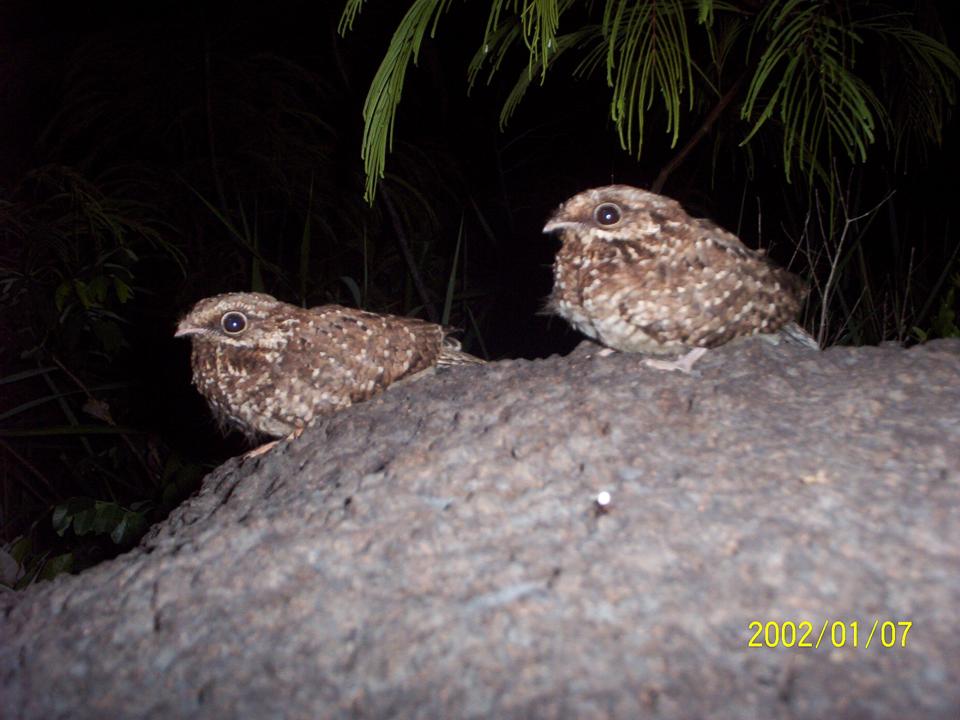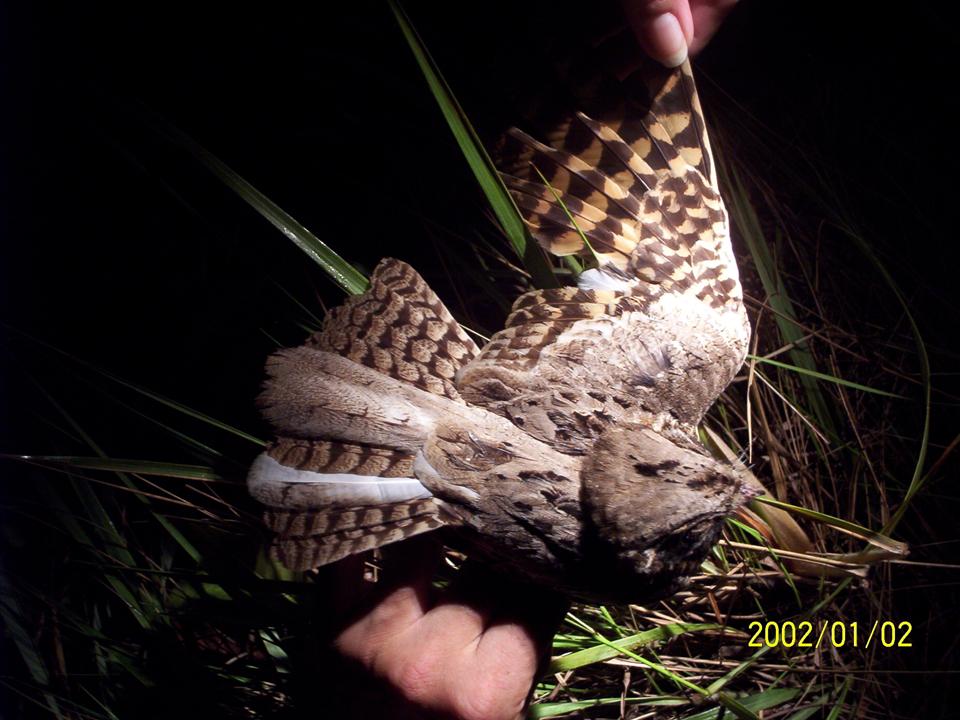CONFIRMATION OF BREEDING OF E.candicans AT ESTANCIA LAGUNA BLANCA
At approximately 8.30pm on November 10 2005 close to the northern boundary of the estancia we encountered five individuals of this species together engaged in what may have been a lek display. At least one adult male was present and four “female-type” birds were in attendance. No vocalizations or audible wing noises were heard (Clay et al 2000) and the group dispersed before we were able to make behavioural observations.
Approximately 25m from this interaction we found a pair of fledglings perched on a low termite mound approximately 30cm high and 60cm in diameter (Fig 2). They already possessed the diagnostic head pattern of adult birds and the characteristic jizz of the species.


Eleothreptus candicans IN PARAGUAY
Thanks largely to fieldworkers in Paraguay the species has gone from one of the least known caprimulgids to one of the better documented in a few short years. Clay et al (1998) provide the first description of the female, eggs and nest of the species, Pople (2003) accurately details the ecology of the species and Clay et al (2000) documents the lekking display. Most fieldwork has been conducted at Aguara Ñu, Mbaracayú Biosphere Reserve, Departamento Candindeyú where the species was first discovered in 1995 (Lowen et al 1996a & b). Following a grant from the Neotropical Bird Club a search for further populations of the species in Paraguay was launched and resulted in the discovery of a second population at Laguna Blanca, Departamento San Pedro.
FIG 1: Immature male of Eleothreptus candicans in moult, showing white adult feathers on wings and tail, photographed at Estancia Laguna Blanca November 2005 (Photo Paul Smith).
CONFIRMATION OF BREEDING OF Eleothreptus candicans AT ESTANCIA LAGUNA BLANCA, PARAGUAY WITH SOME NOTES ON FIELD IDENTIFICATION AND THREATS AT THE SITE
Paul Smith, Hugo del Castillo, Hemme Batjes, Bryan Wainwright

INTRODUCTION
The endangered White-winged Nightjar Eleothreptus candicans is one of the world´s rarest caprimulgids with an estimated global population of just 1000-2500 individuals (Birdlife International 2004). Though there are historical records from a scattering of locations in Paraguay and Brazil (Hayes 1995, Rodrigues 1999, Clay and del Castillo 2004) and two recent records from Beni, Bolivia (Davis 1994, Grim 2006), only three sites worldwide, two of which are in Paraguay, are known to support viable populations - Emas National Park, Brazil (250-1000 birds), Mbaracayú Biosphere Reserve, Paraguay (40-150 birds) and Laguna Blanca, Paraguay (30-50 birds). Here we present data of the first confirmed breeding of this species at Laguna Blanca, with some notes on its ecology and field identification. We also detail the threats facing this globally important cerrado site.

FIG 2: Two fledglings of Eleothreptus candicans photographed at Estancia Laguna Blanca 10 November 2005 (Photo Paul Smith).
E. candicans AT LAGUNA BLANCA
Since the discovery of this second population most fieldwork in the Laguna Blanca area has focused on Estancia Laguna Blanca, though the species also occurs on immediately adjacent estancias. Estancia Laguna Blanca is a 2500ha estate of global conservation importance consisting of a mosaic of pristine cerrado-type habitats, and with a total of 10 globally-threatened and 4 near-threatened species reported to occur there (Smith et al 2005, Smith & del Castillo in press). At Mbaracayú the nightjar is associated with dwarf palm (Butia paraguayensis) cerrado (Mazar Barnett & Madroño 2003), though no such habitat exists at Laguna Blanca where it is closely associated with sensu strictu cerrado dominated by a ground cover of the low-growing Sapoacean shrub Pouteria subcaerulerae - mainly in the northern and western sections of the estancia. During fieldwork in November 2005 all but one of our numerous records of the species where in such habitat, the exception being a male flying over a recently ploughed field on a neighbouring estancia, immediately adjacent to typical habitat. During night drives we found the species easy to find in the correct habitat, where it was generally the commonest nightjar, other nightjar species occupying different niches within the mosaic of cerrado habitats available (Smith et al 2005).
FIELD IDENTIFICATION E. candicans AT LAGUNA BLANCA
The dramatic white wing and tail pattern of males makes them unmistakeable (Cleere & Ranft 1998), but females and juvenile birds lack white on the plumage and can be more problematic. At rest birds in all plumages are recognizable by their distinctive big-eyed, big-headed, short-tailed jizz, unlike that of any other small nightjar occurring in Paraguay. The broad pale supercilium and malar are conspicuous on closer approach. Males usually show some white in the wing and tail even at rest.
The relaxed, lazy flight-style of this species with much tilting and gliding is distinctive when learnt, the bird appearing to float through the air with an almost butterfly-like grace. Adult males show considerably more white on the plumage than any other nightjar species. Adult females and juveniles can be distinguished from each other in the hand (the former appearing slightly browner overall and the latter greyer), though it is not usually possible in the field. In flight both give the impression of a pale, small, short-tailed nightjar, with short, rounded wings. One character that we found particularly useful in identifying females (and presumably also juveniles) in flight is that the dark upper breast appears to be quite sharply demarcated from the paler, buffier lower breast and underwing. (Smith and Clay in press).
Though seven species of caprimulgidae occur at Laguna Blanca (Smith and del Castillo in press), the only species of similar size that is likely to be confused is Little Nightjar Caprimulgus parvulus. Both males and females of that species show a pale patch near the tip of the wing, which is absent in both sexes of E.candicans. C.parvulus freely sits on roads (which E.candicans never does), and has a different habitat preference, preferring the intersection between edge of cerradón and bushy campo sucio cerrado (Smith and del Castillo in press). It was never seen to occur in the Pouteria-dominated areas preferred by E.candicans. The flight-style of this species is much more swift and direct, on longer, more pointed wings and with a clearly longer tail.
Both birds were similar in plumage, predominately rufous-brown with a broad white malar and greyish supercilium. They were spotted buff and barred black on the upper breast and appeared to be somewhat paler and whiter on the belly. The upperparts were mostly rufous-brown, flecked liberally with buff (especially on the wings) and black. The crown was centrally brown (blacker on the rear crown), with the grey of the supercilium extending up onto the sides (more conspicuously in one bird than the other). Neither bird showed any white on the wings or tail.
We were able to closely approach the birds but elected not to handle them to avoid breeding disturbance of this rare species. If approached too closely the birds would scuttle crablike a few centimetres sideways with rapid movements of the pinkish feet, but at no stage did they leave the termite mound and seemed to be incapable of flight. They showed no sign of alarm and did not utter any sound, suggesting that their only form of defence is their cryptic colouration - which fairly closely matched the colour of the termite mound on which they were perched. These fledglings represent the first confirmation of breeding at Laguna Blanca.
THREATS
Eleothreptus candicans is in a perilous conservation state globally (Birdlife International 2004), but the four sites at which it is known to occur all receive some level of protection. Of these Laguna Blanca is the only one which is not protected by law (Coconier 2004), though the owner of the Estancia, Malvina Duarte, is keen to promote conservation if it can be shown to be economically viable. The cerrado there is home to 14 species of conservation concern (including Lesser Nothura Nothura minor, Cock-tailed Tyrant Alectrurus tricolor, Black-masked Finch Coryphaspiza melanotis and Crowned Eagle Harpyhaliaetus coronatus amongst others), ranking it amongst the most important sites for conservation in southern South America. Globally cerrado is disappearing at an alarming rate (Conservation International 2006), though the situation in Paraguay is not yet as severe as in Brazil, largely because the sandy substrates on which cerrado grows are poor for agriculture. However as pressure for land increases in Paraguay, so will the pressure on the cerrado and measures to cement their conservation should be taken as soon as possible (Coconier 2004). Several other estancias in the surrounding area have been invaded by campesinos (landless peasants) and the threat of illegal settlement of the land is constant (del Castillo pers. comm.). Currently Sra Duarte is trying to promote sustainable eco-tourism in a bid to cover the running costs at the Estancia, and the cerrado area is available for hire for the comparatively low sum of US$300 per month. She has received rental offers from cattle ranchers, a move that would be potentially disastrous for the cerrado, but is keen to pursue more eco-friendly options.
REFERENCES
1.Birdlife International 2004 - Threatened Birds of the World 2004 CD-Rom
2.Clay RP, Capper DR, Mazar Barnett J, Burfield IJ, Esquivel EZ, Fariña R, Kennedy CP, Perrens M, Pople RG 1998 - White-winged Nightjar Caprimulgus candicans and Cerrado Conservation: The Key Finings of Project Aguara Ñu 1997 - Cotinga 9: p52-56.
3.Clay RP, del Castillo H 2004 - Annotated Checklist of the Birds of Paraguay - Guyra Paraguay, Asunción.
4.Clay RP, Lopez-Lanus B, Tobias JA, Lowen JC, Mazar Barnett J 2000 - The Display of the White-winged Nightjar - Journal of Field Ornithology 71: p619-626.
5.Cleere N, Ranft R 1998 - Nightjars: A Guide to Nightjars and Related Nightbirds - Pica Press, East Sussex.
6.Coconier EG 2004 - Project Conservation of the Paraguayan Cerrado - Guyra Paraguay
7.Conservation International 2006 website www.conservation.org
8.Davis SE, Flores E 1994 - First Record of White-winged Nightjar Caprimulgus candicans for Bolivia - Bulletin BOC 114: p127-128.
9.Grim T, Sumbera R 2006 - A New Record of the Endangered White.winged Nightjar Eleothreptus candicans from Beni, Bolivia - Wilson Journal of Ornithology 118: p109-112
10.Hayes FE 1995 - Status, Distribution and Biogeography of the Birds Of Paraguay - American Birding Association Monographs in Field Ornithology Number 1.
11.Lowen JC, Bartrina L, Brooks TM, Clay RP, Tobias J 1996 - Project YACUTINGA 95: Bird Surveys and Conservation Priorities in Eastern Paraguay - Cotinga 5: p14-19.
12.Lowen JC, Bartrina L, Clay RP, Tobias JA 1996 - Biological Surveys and Conservation Priorities in Eastern Paraguay - CSB Conservation Publications
13.Mazar Barnett J, Madroño A 2003 - Aves de la Reserva Natural del Bosque Mbaracayú: Guía para la Identificación de 200 Especies - Fundación Moises Bertoni, Asunción.
14.Pople RG 2003 - The Ecology and Conservation of the White-winged Nightjar Caprimulgus candicans - PhD Dissertation University of Cambridge.
15.Rodrigues FHG, Hass A, Marini-Filho OJ, Guimaraes MM, Bagno MA 1999 - A New Record of White-winged Nightjar Caprimulgus candicans in Emas National Park, Goiás, Brazil - Cotinga 11: p83-85.
16.Smith P, del Castillo H, Latas P in press - Guia de Campo de las Aves de Estancia Laguna Blanca / Field Guide to the Birds of Estancia Laguna Blanca: Mini-guías de las Aves del Paraguay Volumen 2 - Guyra Paraguay, Asuncion.
17.Smith P, del Castillo H, Hemme Batjes, Monica Montiel and Bryan Wainwright 2005 - An Avifaunal Inventory of Estancia Laguna Blanca, Departamento San Pedro, South-Eastern Paraguay - FAUNA Paraguay Technical Publication Number 2, Encarnación.
18 Smith P, Clay R in press - A Field Guide to the Birds of Paraguay - Helm
Designed by Paul Smith 2006. This website is copyrighted by law.
Material contained herewith may not be used without the prior written permission of FAUNA Paraguay.
Photographs on this web-site were taken by Paul Smith, Hemme Batjes, Regis Nossent,
Alberto Esquivel, Arne Lesterhuis, José Luis Cartes, Rebecca Zarza and Hugo del Castillo and are used with their permission.



